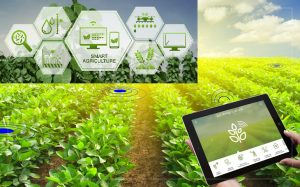In the United States, outdoor water use alone averages more than 9 billion gallons of water each day, mainly for landscape irrigation. As much as 50% of this water is wasted due to over-watering caused by inefficiencies in traditional irrigation methods and systems. Smart irrigation technology is the answer.
Smart Irrigation System is an automated, well maintained irrigation system which monitors soil conditions and water use. With emerging technologies it can automatically adjust according to the scheduling and real time feedback it is receiving from the field. This is one time investment project and especially effective for the continually growing human population.
As per the traditional system, supply of water to plants is not monitored properly. Implementing smart irrigation helps to decrease the loss of water caused by using traditional system of irrigation as well as taking action on problem areas detected.

 Working with Smart Irrigation System using IoT
Internet of Things (IoT) solutions, based on the application specific sensors’ data acquisition and intelligent processing, are bridging the gap between the cyber and physical worlds.
Unlike traditional irrigation controllers that operate on a preset programmed schedule and timers, smart irrigation controllers or sensing nodes monitor weather, soil moisture, soil temperature, air temperature, Ultraviolet (UV) light radiation and relative humidity of the crop field to automatically adjust the watering schedule to actual conditions of the site.
Evapo Рtranspiration (ET),  thermal  imaging, capacitive  methods, and  neutron scattering  method and  gypsum blocks are some of the technologies that enable moisture sensing.
There are various types of sensors available for these types of smart farm solutions. Capacitive sensors, however instantaneous, are costly and need to be calibrated often with varying temperature and soil type. Neuron probe based moisture sensors are very accurate but present radiation hazards, calibration difficulty and are costly.  For a large agriculture field, moisture measurement at a single location in the field does not make much sense or paint a realistic picture of the entire space. Hence what is required is a distributed number of sensor nodes and scattered pumping units to pump water to those specific locations covered by the sensor units. This system is composed of distributed wireless sensor network with soil moisture and temperature sensors.
Gateway units are used to transfer data from sensor units to base station,  send commands  to actuators  for  irrigation  control and manage the flow of data from the sensor unit to the cloud. Algorithms can be effectively deployed in the gateway for controlling water quantity as per the requirements and condition of the field at a given moment. These are programmed in the micro-controller and can send commands through the actuator to control water quantity through a valve unit. Whole systems can be effectively powered by photo-voltaic panels to reduce energy costs and allow for remote sensors to be deployed. Communication is traditionally duplex in these systems and takes place through a cellular network or narrow band that travels long distances.  Web applications manage the irrigation through continuous monitoring and irrigation scheduling programming. Basically, it can be done from the browser on your computer.
The sensor node data is wirelessly collected by the cloud utilizing web-services and visualization. Decision support systems provides real-time insights based on the analysis of sensors data and weather forecast data.
As per United Nations the current world population of 7.6 billion is expected to reach 8.6 billion in 2030 and 9.8 billion by 2050. Smart farming is a futuristic approach to alleviate obstacles triggered by ever increasing population and fast urbanization which is going to benefit the government as well as the masses.
Smart irrigation helps to minimize the environmental footprint through efficient water use. It allows reinvesting in new and improved technologies which ensure sustainable and responsible irrigation over time. Whether you are an irrigation installer, landscaper, maintenance worker or a home owner, these systems are affordable, save precious water resources and keep landscapes in peak condition.
We are all rapidly reshaping our planet and globally embracing sustainability as the battle cry for a viable future.¬†Citizen engagement is essential to any population’s efforts to reduce its environmental impact.¬† IOT-enabled projects like these have the potential to¬†bring awareness, optimize usage of natural resources and create real change for a sustainable future.


